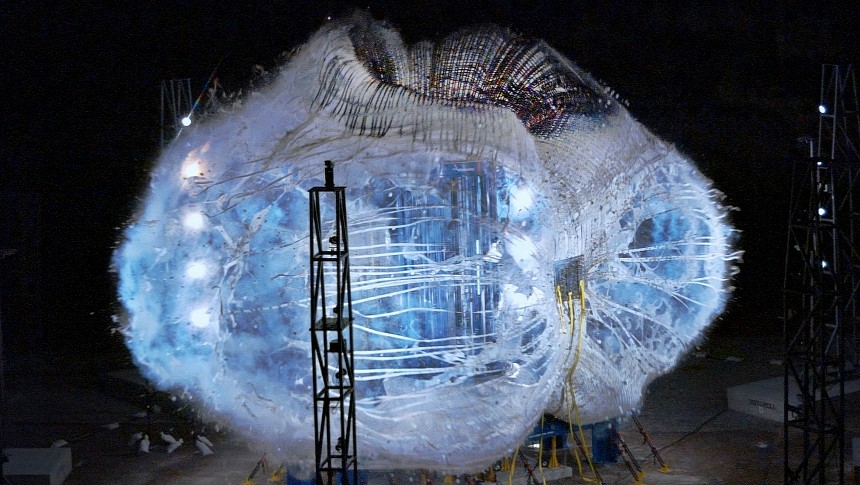With their miniature Space Shuttle replacement Dream Chaser due to launch this April, Sierra Space is one of the busiest private spaceflight firms in North America right now. But with Tenacity nearing completion, the space-savvy legal offshoot of Sierra Nevada has something else to celebrate. The firm's advancements in future commercial orbital space stations are just as notable as their spaceplanes.
With NASA's Marshall Space Flight Center playing the host, Sierra Space just concluded its first full-scale structural test for a semi-rigid expandable space station platform that could replace the International Space Station. Dubbed the Large Intergrated Flexible Environment (LIFE) project, testing of a scaled-down model's external pressure shell was highlighted by a dramatic "Ultimate Burst Test" (UBP). Wherein the model station's pressure shell is inflated with pressures well beyond what it would endure in low-Earth orbit with human astronauts on board.
With assistance from Sierra Space's project partners at ILC Dover in Frederica, Delaware, the dynamic team successfully inflated the LIFE project test article to a pressure of 77 psi (5.30 bar) before structural failure caused the structure to burst outward in a manner much befitting of its test name. With ILC Dover's industry-heavyweight composite build materials, the 300 cubic-meter structure was capable of maintaining a pressure far above the maximum pressure, 60.8 psi (4.19 bar), that NASA engineers have deemed nominal for long-term human occupation in low-Earth orbit and potentially far beyond.
When stored inside a five-meter fairing, the LIFE inflatable space station platform is no different than other medium-lift launch vehicle payloads. But when fully deployed and pressurized to a human-safe operating environment, future stations will grow to sizes as large as a three-story apartment building. In its primordial form, the LIFE project's first prototype was already a third the size of the International Space Station. Is it a sign that football-sized space stations the caliber of ISS could one day become standard? Perhaps even almost routine? If the consistent occupation of these structures is safe from micrometeoroid and orbital debris, the answer depends on such tests.
"We are driving the reinvention of the space station that will shape a new era of humanity’s exploration and discovery in Low Earth Orbit and beyond. Sierra Space’s inflatable space station technology offers the absolute largest in-space pressured volume, the best unit economics per on-orbit volume, and the lowest launch and total operating costs," proudly proclaimed Sierra Space CEO Tom Vice, his company's semi-rigid space station hardware now among the gold standard in the sector. "Having the best unit economics positions Sierra Space as the category leader in microgravity research and product development, providing customers with the most attractive return on their investment."
Future prototypes in the LIFE program are slated to exceed the International Space Station in size, coming in at a very healthy 1,400 cubic meters. By the time the technology is ready for transport to space, there's no telling how large future inflatable space stations could be. Are semi-rigid office buildings in space the future of commercial spaceflight? Let us know what you think in the comments down below.
With assistance from Sierra Space's project partners at ILC Dover in Frederica, Delaware, the dynamic team successfully inflated the LIFE project test article to a pressure of 77 psi (5.30 bar) before structural failure caused the structure to burst outward in a manner much befitting of its test name. With ILC Dover's industry-heavyweight composite build materials, the 300 cubic-meter structure was capable of maintaining a pressure far above the maximum pressure, 60.8 psi (4.19 bar), that NASA engineers have deemed nominal for long-term human occupation in low-Earth orbit and potentially far beyond.
When stored inside a five-meter fairing, the LIFE inflatable space station platform is no different than other medium-lift launch vehicle payloads. But when fully deployed and pressurized to a human-safe operating environment, future stations will grow to sizes as large as a three-story apartment building. In its primordial form, the LIFE project's first prototype was already a third the size of the International Space Station. Is it a sign that football-sized space stations the caliber of ISS could one day become standard? Perhaps even almost routine? If the consistent occupation of these structures is safe from micrometeoroid and orbital debris, the answer depends on such tests.
"We are driving the reinvention of the space station that will shape a new era of humanity’s exploration and discovery in Low Earth Orbit and beyond. Sierra Space’s inflatable space station technology offers the absolute largest in-space pressured volume, the best unit economics per on-orbit volume, and the lowest launch and total operating costs," proudly proclaimed Sierra Space CEO Tom Vice, his company's semi-rigid space station hardware now among the gold standard in the sector. "Having the best unit economics positions Sierra Space as the category leader in microgravity research and product development, providing customers with the most attractive return on their investment."
Future prototypes in the LIFE program are slated to exceed the International Space Station in size, coming in at a very healthy 1,400 cubic meters. By the time the technology is ready for transport to space, there's no telling how large future inflatable space stations could be. Are semi-rigid office buildings in space the future of commercial spaceflight? Let us know what you think in the comments down below.





